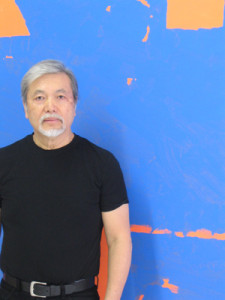Born in Machida, Tokyo in 1936. Nakazato attended Tama Art University and continued his art studies at the University of Wisconsin and the University of Pennsylvania. Receiving the John. D. Rockefeller III Fund Grant, he first lived in Manhattan from 1966 – 1967 returning to Tokyo in 1968 and taught at his alma mater. The faculty at the time included critic Ichiro Haryu, artists Ghiju (Yoshishige) Saito, Jiro Takamatsu, Lee U-Fan. In 1971, Nakazato was forced to leave the University under stress of the student uprising and returned to the U.S. He lived in Manhattan until his death in 2010.
1970 was a significant year for Nakazato, when he had his first solo exhibition in Tokyo at the Pinar Gallery, and painted a 5 meter x 25 meter mural at the Furukawa Pavilion at Expo ’70 Osaka. In 1971, he was selected for the Japan Art Festival Exhibition at the Guggenheim Museum in New York. Through his introduction to Tokyo Gallery by Ghiju Saito, he held six solo shows there working with art dealer, Takeshi Matsumoto. He had two solo museum exhibitions, in 1987 at the Hara Museum of Contemporary in Tokyo, and in 2010 at the Machida City Museum of Graphic Arts.
Nakazato’s works both in paintings and prints have a uniquely well-informed international perspective with his experiences growing up in post World War II Japan, the American printmaking renaissance of the early 1960’s while he studied printmaking in Wisconsin, his exposure to the New York art scene in the mid 1960’s through the many Abstract Expressionists as visiting artists at the University of Pennsylvania (The chair of the Graduate School of Fine Arts at the time was Italian painter, Piero Dorazio.), his continuous shuttling back and forth between New York and Tokyo along with trips to Europe and elsewhere.
Nakazato’s works are conceptual and minimalist throughout and despite some flirtations to work off canvas in the early 1970’s, he described his determination to work on canvas and paper using baseball as a metaphor, the decision to the play the game. Choosing to work non-representationally, he explored proportions and placements through geometry in his large-size paintings and prints.
The early severe monotone expressions gave way to more colors in the mid 1980’s, and in 1992 while holding a solo exhibition at the Kuranuki Gallery (renamed Art Court Gallery) in Osaka located in the same building as the Idemitsu Collection, he rediscovered the Japanese Zen Monk painter Sengai. He was drawn to Sengai’s paintings of a circle, triangle, and square, which were painted at least 100 years before the European avant-garde artists.
Despite the hackneyed vocabulary of primary shapes throughout Modernism and thereafter, Nakazato was convinced that it was the way to re-examine and transcend Modernism for the 21st century. He called the series the Line Outside Series, a homonym for Sengai in Japanese. The idea was that through this exploration, he could come to a new territory beyond the known. In 2001, he began his 2001 Project which was unfinished at the time of his untimely death in 2010 during his NAKAZATO Hitoshi: New York/Machida – Line Outside/Black Rain solo exhibition.
In 2013, Nakazato’s works were included in a group show entitled Machida Connection at the Museum along with Gempei Akasegawa.
The purpose of creating this website is to celebrate the works of my late beloved husband, Hitoshi Nakazato. By introducing some of his artist’s statements and critiques written about his work by art critics, curators, and an historian, I hope to provide information on Hitoshi’s concepts and philosophies and what he called ‘process as imagemaking.’
The duality of the English and Japanese languages was an intrinsic part of him. He was heavily involved in the translation process going back and forth between the languages of all his statements as well as the critiques. He was very specific about the use of terminologies for his ideas and concepts, and as a result they may not be the same as the terminologies used in some of the –isms he dealt with in his works. Also, in an attempt to make some of the pieces more cogent going into the other language, the expressions may be somewhat different if the Japanese and English are compared side by side. I did the initial translations for many of the translations from 1988. Hitoshi had the final say going both into English and Japanese. It was an extraordinary experience working on the translations with him during our years together and I proudly share them with you.
Sumiko Takeda Nakazato

